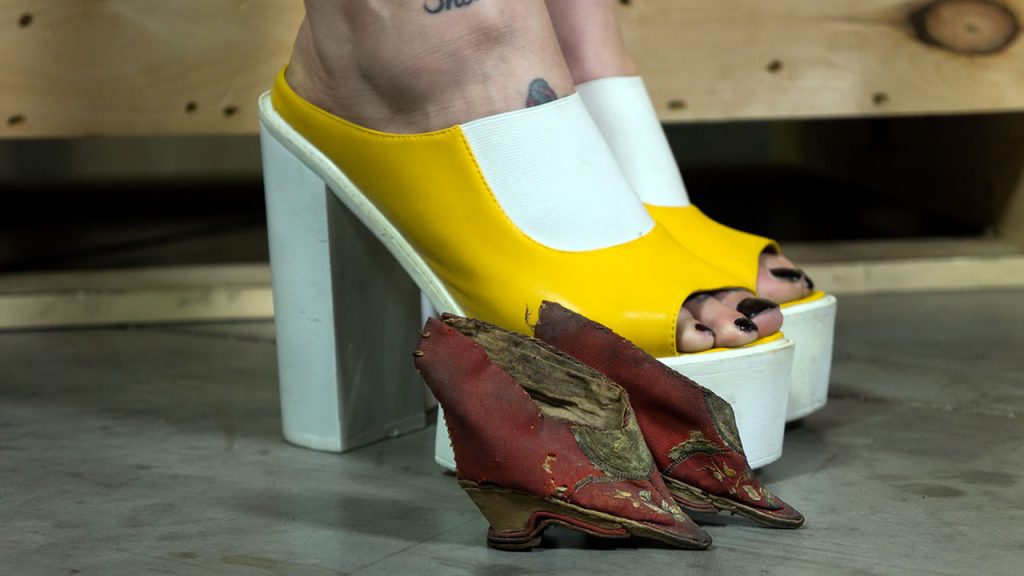Winner of the Fall 2016 StMU History Media Award for
Best Use of Scholarship
Best Article in the Category of “World History”
Best Use of Primary Sources
When I knew I couldn’t suffer another moment of pain and tears fell on my bloody bindings, my mother spoke softly into my ear, encouraging me to go one more hour, one more day, one more week, reminding me of the rewards I would have if I carried on a little longer. In this way, she taught me how to endure—not just the physical trials of footbinding or childbearing, but the more torturous pain of the heart, mind, and soul.1
More often than necessary, women are consumed with the idea of infatuation. Every culture has its own form of standards that pertain to women and what constitutes beauty. Although the world is slightly more accepting now, women used to go to extreme lengths to achieve an image that would be deemed attractive. In the Chinese culture, foot binding was that well-known beauty expectation for centuries. What started off as a celebrity fad, turned into a way of determining social status and eventually an all-around beauty expectation. 2 The objective of foot binding was for women to have the smallest foot possible, starting at very young ages. Not only was this a painful process for girls as young as five years, but it also promoted the idea that women must mutilate their bodies to become appealing to men. At some point in time, women began to just accept that this was something that was supposed to be done in order to be attractive. Often referred to as “lotus boats” or “golden lotuses,” bound feet started as a fad for the famous, and slowly made its way to becoming the social norm.3

This practice began around the tenth century with women in the entertainment business. These women were adored for their tiny arched feet and were seen by men to be much more attractive than middle class women with average feet. As these dancers were gaining an audience, the idea of “lotus feet” was becoming familiar. Not long after these performers expressed their “beauty,” foot binding became a norm for women who wanted to fit in and even for those who had a desire to find a husband.4 This painful process consisted of the breaking of young girl’s toes to form the desired triangular shape. Then the arch of the foot would be bent horizontally from the toes all the way to the heel. As if this was not painful enough, the girls were forced to walk on their feet to intensify the arch, breaking the foot even more. After all of this, the foot would be wrapped to maintain the shape of it as well as prevent any sort of deviation.5

Although this practice was around for centuries, it was only a matter of time before someone realized how inhumane and cruel it really was. Thankfully, many people began to protest against foot binding, forming “anti-foot binding organizations” to raise awareness on the inhumanity of binding women’s feet. By the 1950’s, laws were passed, allowing women to unbind their feet. Although hesitant at first, the trend slowly declined. Many women protested to unbinding their feet, due to the fact that it had been a social norm a thousand years. However, the movement against foot binding continued and eventually the last of the factories that make the tiny shoes were shut down, disabling the women from continuing the custom. Today, foot binding is no longer practiced and the only women who continue to maintain the tiny feet are those elder women who refuse to let go of the past.6
- Lisa See, Snow Flower and the Secret Fan (New York: Random House Publishers, 2005), 3-4. ↵
- Yaodong Gu et al., “Foot Loading Characteristics of Chinese Bound Feet Women: A Comparative Analysis,” PLoS ONE 10, no. 4 (April 2015): 1–9, doi:10.1371/journal.pone.0121695. ↵
- Yu-ning Li, Chinese Women Through Chinese Eyes (New York: Routledge, 2015), 125-127. ↵
- Women in the Middle Ages: An Encyclopedia, 2004, s.v. “Footbinding (Late 10th Century-early 20th Century),” by Patricia Buckley Ebrey. ↵
- Amanda Foreman, “Why Footbinding Persisted in China for a Millennium,” Smithsonian, accessed November 8, 2016, http://www.smithsonianmag.com/history/why-footbinding-persisted-china-millennium-180953971/. ↵
- “Women with Bound Feet in China,” Reshaping the Body: Clothing & Cultural Practice, accessed November 8, 2016, http://exhibits.hsl.virginia.edu/clothes/lady_bound/. ↵



189 comments
Kristy Feather
I remember when I was in elementary school I found a book that talked about feet binding in it. At the time I was too young to realize just how important looks were to people and thought that these women were insane for voluntarily mutilating their feet. Now I see just how sad it is. To think that society can impact one’s thoughts of themself so much that they are willing to torture themselves in the way described here, it’s just unfathomable.
Esperanza Rojas
This article completely creeped me out. I knew the foot binding was a trend but didn’t know the origins of it. I feel like this trend is relatable to today’s beauty standards but not to the extreme. This can be compared to the drastic amounts of physical stress women put themselves through to become the skinny girl that are shown on magazines, although it is hardly forced upon us by our families, it does force a role women must play otherwise suffer the consequences of being judged by appearance. This tradition is shown to be proof of how something this done for so long can be seen as right and done so ignorantly, especially one that is started at age 5.
Pamela Callahan
This article, at times, was hard to read. It was very well written, but the subject is so unbelievable. I can’t believe that women would do this to themselves to increase their beauty. While foot binding may seem like a strange custom in the United States, I’m sure that we have customs that must seem strange to other countries as well. I just wish that these standards weren’t put on women and that they could just be seen as beautiful for being themselves without having to endure so much pain.
Tyanne Pearcy
This article was very interesting as it touched on the pressure women have to endure not only in America but in other countries as well. Foot binding is a cruel and ridiculous trend to be pressured into following just to appeal more attractive to men. What I found interesting is that a law had to be passed for this trend to come to an end. What is sad is that although it may not be as extreme at foot binding, women today go out of their way to get a mans attention. The fact that women feel obligated to go through crazy circumstances to please the opposite sex is something that needs to end.
Sienna Guerra
I remember doing a project about Chinese foot binding in 5th grade. I dislike this method of turning women to be some type of beauty to be attractive to men. It is a very cruel way of changing the appearance of a woman but in that society, laws were even made to end it in 1950. Today, woman are still going through this type of change to their appearance through plastic surgery, makeup, and lasik eye surgery!
Eric Ortega Rodriguez
This article was fascinating yet very hard to read because just the thought of the pain those women must have gone through cannot be matched. I remember back in middle school, foot binding came up in history class and very few people believed this was an actual beauty standard in the past. The pictures used in the article were spot on because just looking at them one can picture the pain those women went through. It is crazy to me to think that it was until the 1950’s that allowed women to unbind their feet, this was not that long ago. Overall, amazingly written article, great work!
Luisa Ortiz
CONGRATULATIONS on winning! this article is one of my favorites, the pictures(ouch!) are excellent, the quote place at the beginning of the article, the title, the layout! (round of applause) I enjoyed how the article is expressive, detail and informative, something that amazed when I was reading the article was the process of bedding the foot. I could not imagine the horrible pain of walking, and even at a young age and how some women still practicing the foot bending!!!!
Crystal Baeza
This article was such a shock to me! I’ve never heard of foot binding and can’t believe women actually did this for appearance matters. I can’t even imagine the pain and suffering they went through. It’s crazy to believe even years before women were changing themselves to fit into society. I’m glad there were organizations to stop this inhumane act and now in today’s world people are becoming more acceptable to their true beauty.
Avery Looney
This article was very interesting and well written! Foot binding is very cruel and inhumane. It is absurd that people willingly partook in this beauty trend just to become more attractive to men. It is also crazy to think that laws were passed to end this trend only in 1950! It is sad that we lived in a society where appearances are everything, and we continue to do so. Today women may not be breaking their feet, but they are going through other jurassic measures to alter their appearances.
Maisie Favila
I found this article interesting because I had a math teacher in 6th grade who experienced foot binding. At the time, I believed it to be a part of Chinese culture, but I now know that it was one of the many beauty standards women are forced into going through with. The act of foot binding is an extreme form of conforming to society’s expectations for women in the fact that they should be petite, when in reality all parts of a woman’s body come in all shapes and sizes.